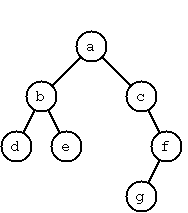 A binary tree is either empty or
it is composed of a root element and two successors, which are binary
trees themselves.
A binary tree is either empty or
it is composed of a root element and two successors, which are binary
trees themselves.These are an adaptation of the Ninety-Nine Prolog Problems written by Werner Hett at the Berne University of Applied Sciences in Berne, Switzerland. I (Phil Gold) have altered them to be more amenable to programming in Scala. Feedback is appreciated, particularly on anything marked TODO.
The problems have different levels of difficulty. Those marked with a single asterisk (*) are easy. If you have successfully solved the preceeding problems you should be able to solve them within a few (say 15) minutes. Problems marked with two asterisks (**) are of intermediate difficulty. If you are a skilled Scala programmer it shouldn't take you more than 30-90 minutes to solve them. Problems marked with three asterisks (***) are more difficult. You may need more time (i.e. a few hours or more) to find a good solution. The difficulties were all assigned for the Prolog problems, but the Scala versions seem to be of roughly similar difficulty.
Your goal should be to find the most elegant solution of the given problems. Efficiency is important, but clarity is even more crucial. Some of the (easy) problems can be trivially solved using built-in functions. However, in these cases, you learn more if you try to find your own solution.
Solutions are available by clicking on the link at the beginning of the problem description.
[I don't have example solutions to all of the problems yet. I'm working on getting them all done, but in the meantime, contributed solutions, particularly from seasoned Scala programmers would be appreciated. If you feel a particular problem can be solved in a better manner than I did, please let me know that, too. <PMG>]
In Scala, lists are objects of type List[A],
where A can be any type. Lists are effective for many
recursive algorithms, because it's easy to add elements to the head of
a list, and to get the tail of the list, which is everything but the
first element.
The solutions to the problems in this section will be in objects
named after the problems (P01, P02, etc.). You can compile the source
files with scalac and thereafter use import
to bring the functions into scope. Some of the problems can be solved
easily by using imported solutions to previous problems.
In many cases, there's more than one reasonable approach. The files linked here may include multiple solutions, with all but one commented out. They'll also indicate whether there's a builtin method in Scala that accomplishes the task.
scala> last(List(1, 1, 2, 3, 5, 8)) res0: Int = 8
scala> penultimate(List(1, 1, 2, 3, 5, 8)) res0: Int = 5
Example:
scala> nth(2, List(1, 1, 2, 3, 5, 8)) res0: Int = 2
scala> length(List(1, 1, 2, 3, 5, 8)) res0: Int = 6
scala> reverse(List(1, 1, 2, 3, 5, 8)) res0: List[Int] = List(8, 5, 3, 2, 1, 1)
scala> isPalindrome(List(1, 2, 3, 2, 1)) res0: Boolean = true
scala> flatten(List(List(1, 1), 2, List(3, List(5, 8)))) res0: List[Any] = List(1, 1, 2, 3, 5, 8)
Example:
scala> compress(List('a, 'a, 'a, 'a, 'b, 'c, 'c, 'a, 'a, 'd, 'e, 'e, 'e, 'e))
res0: List[Symbol] = List('a, 'b, 'c, 'a, 'd, 'e)Example:
scala> pack(List('a, 'a, 'a, 'a, 'b, 'c, 'c, 'a, 'a, 'd, 'e, 'e, 'e, 'e))
res0: List[List[Symbol]] = List(List('a, 'a, 'a, 'a), List('b), List('c, 'c), List('a, 'a), List('d), List('e, 'e, 'e, 'e))(N,
E) where N is the number of duplicates of the
element E.
Example:
scala> encode(List('a, 'a, 'a, 'a, 'b, 'c, 'c, 'a, 'a, 'd, 'e, 'e, 'e, 'e))
res0: List[(Int, Symbol)] = List((4,'a), (1,'b), (2,'c), (2,'a), (1,'d), (4,'e))(N, E) terms.
Example:
scala> encodeModified(List('a, 'a, 'a, 'a, 'b, 'c, 'c, 'a, 'a, 'd, 'e, 'e, 'e, 'e))
res0: List[Any] = List((4,'a), 'b, (2,'c), (2,'a), 'd, (4,'e))Example:
scala> decode(List((4, 'a), (1, 'b), (2, 'c), (2, 'a), (1, 'd), (4, 'e)))
res0: List[Symbol] = List('a, 'a, 'a, 'a, 'b, 'c, 'c, 'a, 'a, 'd, 'e, 'e, 'e, 'e)pack); do all the work
directly.
Example:
scala> encodeDirect(List('a, 'a, 'a, 'a, 'b, 'c, 'c, 'a, 'a, 'd, 'e, 'e, 'e, 'e))
res0: List[(Int, Symbol)] = List((4,'a), (1,'b), (2,'c), (2,'a), (1,'d), (4,'e))scala> duplicate(List('a, 'b, 'c, 'c, 'd))
res0: List[Symbol] = List('a, 'a, 'b, 'b, 'c, 'c, 'c, 'c, 'd, 'd)scala> duplicateN(3, List('a, 'b, 'c, 'c, 'd))
res0: List[Symbol] = List('a, 'a, 'a, 'b, 'b, 'b, 'c, 'c, 'c, 'c, 'c, 'c, 'd, 'd, 'd)scala> drop(3, List('a, 'b, 'c, 'd, 'e, 'f, 'g, 'h, 'i, 'j, 'k))
res0: List[Symbol] = List('a, 'b, 'd, 'e, 'g, 'h, 'j, 'k)Example:
scala> split(3, List('a, 'b, 'c, 'd, 'e, 'f, 'g, 'h, 'i, 'j, 'k))
res0: (List[Symbol], List[Symbol]) = (List('a, 'b, 'c),List('d, 'e, 'f, 'g, 'h, 'i, 'j, 'k))Example:
scala> slice(3, 7, List('a, 'b, 'c, 'd, 'e, 'f, 'g, 'h, 'i, 'j, 'k))
res0: List[Symbol] = List('d, 'e, 'f, 'g)scala> rotate(3, List('a, 'b, 'c, 'd, 'e, 'f, 'g, 'h, 'i, 'j, 'k))
res0: List[Symbol] = List('d, 'e, 'f, 'g, 'h, 'i, 'j, 'k, 'a, 'b, 'c)
scala> rotate(-2, List('a, 'b, 'c, 'd, 'e, 'f, 'g, 'h, 'i, 'j, 'k))
res1: List[Symbol] = List('j, 'k, 'a, 'b, 'c, 'd, 'e, 'f, 'g, 'h, 'i)Example:
scala> removeAt(1, List('a, 'b, 'c, 'd))
res0: (List[Symbol], Symbol) = (List('a, 'c, 'd),'b)scala> insertAt('new, 1, List('a, 'b, 'c, 'd))
res0: List[Symbol] = List('a, 'new, 'b, 'c, 'd)scala> range(4, 9) res0: List[Int] = List(4, 5, 6, 7, 8, 9)
scala> randomSelect(3, List('a, 'b, 'c, 'd, 'f, 'g, 'h))
res0: List[Symbol] = List('e, 'd, 'a)
Hint: Use the solution to problem P20
scala> lotto(6, 49) res0: List[Int] = List(23, 1, 17, 33, 21, 37)
Example:
scala> randomPermute(List('a, 'b, 'c, 'd, 'e, 'f))
res0: List[Symbol] = List('b, 'a, 'd, 'c, 'e, 'f)C(12,3) = 220
possibilities (C(N,K) denotes the well-known binomial
coefficient). For pure mathematicians, this result may be great.
But we want to really generate all the possibilities.
Example:
scala> combinations(3, List('a, 'b, 'c, 'd, 'e, 'f))
res0: List[List[Symbol]] = List(List('a, 'b, 'c), List('a, 'b, 'd), List('a, 'b, 'e), ...Example:
scala> group3(List("Aldo", "Beat", "Carla", "David", "Evi", "Flip", "Gary", "Hugo", "Ida"))
res0: List[List[List[String]]] = List(List(List(Aldo, Beat), List(Carla, David, Evi), List(Flip, Gary, Hugo, Ida)), ...
b) Generalize the above predicate in a way that we can specify a list of group sizes and the predicate will return a list of groups.
Example:
scala> group(List(2, 2, 5), List("Aldo", "Beat", "Carla", "David", "Evi", "Flip", "Gary", "Hugo", "Ida"))
res0: List[List[List[String]]] = List(List(List(Aldo, Beat), List(Carla, David), List(Evi, Flip, Gary, Hugo, Ida)), ...
Note that we do not want permutations of the group members; i.e. ((Aldo, Beat), ...) is the same solution as ((Beat, Aldo), ...). However, we make a difference between ((Aldo, Beat), (Carla, David), ...) and ((Carla, David), (Aldo, Beat), ...).
You may find more about this combinatorial problem in a good book on discrete mathematics under the term "multinomial coefficients".
Example:
scala> lsort(List(List('a, 'b, 'c), List('d, 'e), List('f, 'g, 'h), List('d, 'e), List('i, 'j, 'k, 'l), List('m, 'n), List('o)))
res0: List[List[Symbol]] = List(List('o), List('d, 'e), List('d, 'e), List('m, 'n), List('a, 'b, 'c), List('f, 'g, 'h), List('i, 'j, 'k, 'l))
b) Again, we suppose that a list contains elements that are lists themselves. But this time the objective is to sort the elements according to their length frequency; i.e. in the default, sorting is done ascendingly, lists with rare lengths are placed, others with a more frequent length come later.
Example:
scala> lsortFreq(List(List('a, 'b, 'c), List('d, 'e), List('f, 'g, 'h), List('d, 'e), List('i, 'j, 'k, 'l), List('m, 'n), List('o)))
res1: List[List[Symbol]] = List(List('i, 'j, 'k, 'l), List('o), List('a, 'b, 'c), List('f, 'g, 'h), List('d, 'e), List('d, 'e), List('m, 'n))
Note that in the above example, the first two lists in the result have length 4 and 1 and both lengths appear just once. The third and fourth lists have length 3 and there are two list of this length. Finally, the last three lists have length 2. This is the most frequent length.
For the next section, we're going to take a different tack with
the solutions. We'll declare a new class, S99Int, and
an implicit conversion from regular Ints.
The arithmetic1 file contains the
starting definitions for this section. Each individual solution
will show the relevant additions to the S99Int class.
The full class will be given at the end of the section.
scala> 7.isPrime res0: Boolean = true
scala> gcd(36, 63) res0: Int = 9
scala> 35.isCoprimeTo(64) res0: Boolean = true
phi(m).phi(m) is
defined as the number of positive integers
r (1 <= r <= m) that are coprime
to m.
scala> 10.totient res0: Int = 4
scala> 315.primeFactors res0: List[Int] = List(3, 3, 5, 7)
scala> 315.primeFactorMultiplicity res0: List[(Int, Int)] = List((3,2), (5,1), (7,1))
Alternately, use a Map for the result.
scala> 315.primeFactorMultiplicity res0: Map[Int,Int] = Map(3 -> 2, 5 -> 1, 7 -> 1)
phi(m>) can be efficiently calculated as
follows: Let [[p1, m1],
[p2, m2],
[p3, m3], ...] be the list of
prime factors (and their multiplicities) of a given
number m. Then phi(m) can be calculated with
the following formula:
phi(m) = (p1-1)*p1(m1-1) * (p2-1)*p2(m2-1) * (p3-1)*p3(m3-1) * ...
Note that ab stands for the bth power of a.
scala> listPrimesinRange(7 to 31) res0: List[Int] = List(7, 11, 13, 17, 19, 23, 29, 31)
scala> 28.goldbach res0: (Int, Int) = (5,23)
scala> printGoldbachList(9 to 20) 10 = 3 + 7 12 = 5 + 7 14 = 3 + 11 16 = 3 + 13 18 = 5 + 13 20 = 3 + 17
In most cases, if an even number is written as the sum of two prime numbers, one of them is very small. Very rarely, the primes are both bigger than, say, 50. Try to find out how many such cases there are in the range 2..3000.
Example (minimum value of 50 for the primes):
scala> printGoldbachListLimited(1 to 2000, 50) 992 = 73 + 919 1382 = 61 + 1321 1856 = 67 + 1789 1928 = 61 + 1867
The file containing the full class for this section is arithmetic.scala.
As in the previous section, we will start with a skeleton file, logic1.scala, and add code to it for each problem. The difference here is that the file starts out almost empty.
and, or, nand, nor, xor, impl,
and equ (for logical equivalence) which return true
or false according to the result of their respective operations;
e.g. and(A, B) is true if and only if both A
and B are true.
scala> and(true, true) res0: Boolean = true scala> xor(true. true) res1: Boolean = false
A logical expression in two variables can then be written as an
function of two variables, e.g: (a: Boolean, b: Boolean) =>
and(or(a, b), nand(a, b))
Now, write a function called table2 which prints the
truth table of a given logical expression in two variables.
scala> table2((a: Boolean, b: Boolean) => and(a, or(a, b))) A B result true true true true false true false true false false false false
and, or, etc as operators.
(i.e. make them methods of a new class with an implicit conversion
from Boolean.) not will have to be left as a object
method.
scala> table2((a: Boolean, b: Boolean) => a and (a or not(b))) A B result true true true true false true false true false false false false
Find out the construction rules and write a function to generate Gray codes.
scala> gray(3) res0 List[String] = List(000, 001, 011, 010, 110, 111, 101, 100)
See if you can use memoization to make the function more efficient.
We suppose a set of symbols with their frequencies, given as a
list of (S, F) Tuples. E.g. (("a", 45),
("b", 13), ("c", 12), ("d", 16), ("e", 9), ("f", 5)).
Our objective is to construct a list of (S, C)
Tuples, where C is the Huffman code word for the
symbol S.
scala> huffman(List(("a", 45), ("b", 13), ("c", 12), ("d", 16), ("e", 9), ("f", 5)))
res0: List[String, String] = List((a,0), (b,101), (c,100), (d,111), (e,1101), (f,1100)) A binary tree is either empty or
it is composed of a root element and two successors, which are binary
trees themselves.
A binary tree is either empty or
it is composed of a root element and two successors, which are binary
trees themselves.
We shall use the following classes to represent binary trees.
(Also available in tree1.scala.) An End
is equivalent to an empty tree. A Branch has a value, and two
descendant trees. The toString functions are
relatively arbitrary, but they yield a more compact output than
Scala's default. Putting a plus in front of the T
makes the class covariant; it will be able to hold subtypes
of whatever type it's created for. (This is important so
that End can be a singleton object; as a singleton, it
must have a specific type, so we give it type Nothing,
which is a subtype of every other type.)
sealed abstract class Tree[+T]
case class Node[+T](value: T, left: Tree[T], right: Tree[T]) extends Tree[T] {
override def toString = "T(" + value.toString + " " + left.toString + " " + right.toString + ")"
}
case object End extends Tree[Nothing] {
override def toString = "."
}
object Node {
def apply[T](value: T): Node[T] = Node(value, End, End)
}
The example tree on the right is given by
Node('a',
Node('b', Node('d'), Node('e')),
Node('c', End, Node('f', Node('g'), End)))
A tree with only a root node would be Node('a') and an
empty tree would be End.
Throughout this section, we will be adding methods to the classes
above, mostly to Tree.
Define an object named Tree. Write a
function Tree.cBalanced to construct completely
balanced binary trees for a given number of nodes. The function
should generate all solutions. The function should take as
parameters the number of nodes and a single value to put in all
of them.
scala> Tree.cBalanced(4, "x") res0: List(Node[String]) = List(T(x T(x . .) T(x . T(x . .))), T(x T(x . .) T(x T(x . .) .)), ...
isSymmetric
method to the Tree class to check whether a given binary tree is
symmetric. Hint: Write an isMirrorOf method first to
check whether one tree is the mirror image of another. We are
only interested in the structure, not in the contents of the nodes.
scala> Node('a', Node('b'), Node('c')).isSymmetric
res0: Boolean = truescala> End.addValue(2) res0: Node[Int] = T(2 . .) scala> res0.addValue(3) res1: Node[Int] = T(2 . T(3 . .)) scala> res1.addValue(0) res2: Node[Int] = T(2 T(0 . .) T(3 . .))
Hint: The abstract definition of addValue
in Tree should be def addValue[U >: T
<% Ordered[U]](x: U): Tree[U]. The >: T is
because addValue's parameters need to
be contravariant in T. (Conceptually,
we're adding nodes above existing nodes. In order for the
subnodes to be of type T or any subtype, the upper
nodes must be of type T or any supertype.)
The <% Ordered[U] allows us to use
the < operator on the values in the tree.
Use that function to construct a binary tree from a list of integers.
scala> Tree.fromList(List(3, 2, 5, 7, 1)) res3: Node[Int] = T(3 T(2 T(1 . .) .) T(5 . T(7 . .)))
Finally, use that function to test your solution to P56.
scala> Tree.fromList(List(5, 3, 18, 1, 4, 12, 21)).isSymmetric res4: Boolean = true scala> Tree.fromList(List(3, 2, 5, 7, 4)).isSymmetric res5: Boolean = false
scala> Tree.symmetricBalancedTrees(5, "x") res0: List[Node[String]] = List(T(x T(x . T(x . .)) T(x T(x . .) .)), T(x T(x T(x . .) .) T(x . T(x . .))))
Write a method Tree.hbalTrees to construct
height-balanced binary trees for a given height with a supplied value
for the nodes. The function should generate all solutions.
scala> Tree.hbalTrees(3, "x") res0: List[Node[String]] = List(T(x T(x T(x . .) T(x . .)) T(x T(x . .) T(x . .))), T(x T(x T(x . .) T(x . .)) T(x T(x . .) .)), ...
minHbalNodes
that takes a height and returns MinN.
scala> minHbalNodes(3) res0: Int = 4
On the other hand, we might ask: what is the maximum
height H a height-balanced binary tree with N nodes can
have? Write a maxHbalHeight function.
scala> maxHbalHeight(4) res1: Int = 3
Now, we can attack the main problem: construct all the height-balanced binary trees with a given nuber of nodes.
scala> Tree.hbalTreesWithNodes(4, "x") res2: List[Node[String]] = List(T(x T(x T(x . .) .) T(x . .)), T(x T(x . T(x . .)) T(x . .)), ...
Find out how many height-balanced trees exist for N = 15.
leafCount to count them.
scala> Node('x', Node('x'), End).leafCount
res0: Int = 1leafList to collect them in a list.
scala> Node('a', Node('b'), Node('c', Node('d'), Node('e'))).leafList
res0: List[Char] = List(b, d, e)internalList to collect them
in a list.
scala> Node('a', Node('b'), Node('c', Node('d'), Node('e'))).internalList
res0: List[Char] = List(a, c)atLevel to collect all nodes at a given level in a
list.
scala> Node('a', Node('b'), Node('c', Node('d'), Node('e'))).atLevel(2)
res0: List[Char] = List(b, c)
Using atLevel it is easy to construct a
method levelOrder which creates the level-order sequence
of the nodes. However, there are more efficient ways to do that.
Ends which are not really nodes!) come last.
Particularly, complete binary trees are used as data structures (or addressing schemes) for heaps.
We can assign an address number to each node in a complete binary
tree by enumerating the nodes in levelorder, starting at the root with
number 1. In doing so, we realize that for every node X with
address A the following property holds: The address
of X's left and right successors are 2*A and
2*A+1, respectively, supposed the successors do exist. This
fact can be used to elegantly construct a complete binary tree
structure. Write a method completeBinaryTree that takes
as parameters the number of nodes and the value to put in each node.
scala> Tree.completeBinaryTree(6, "x") res0: Node[String] = T(x T(x T(x . .) T(x . .)) T(x T(x . .) .))
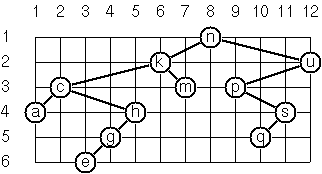 As a preparation for drawing a tree,
a layout algorithm is required to determine the position of each node in
a rectangular grid. Several layout methods are conceivable, one of them
is shown in the illustration on the right.
As a preparation for drawing a tree,
a layout algorithm is required to determine the position of each node in
a rectangular grid. Several layout methods are conceivable, one of them
is shown in the illustration on the right.
In this layout strategy, the position of a node v is obtained by the following two rules:
In order to store the position of the nodes, we add a new class with the additional information.
case class PositionedNode[+T](override val value: T, override val left: Tree[T], override val right: Tree[T], x: Int, y: Int) extends Node[T](value, left, right) {
override def toString = "T[" + x.toString + "," + y.toString + "](" + value.toString + " " + left.toString + " " + right.toString + ")"
}
Write a method layoutBinaryTree that turns a tree of
normal Nodes into a tree
of PositionedNodes.
scala> Node('a', Node('b', End, Node('c')), Node('d')).layoutBinaryTree
res0: PositionedNode[Char] = T[3,1](a T[1,2](b . T[2,3](c . .)) T[4,2](d . .))
The tree at right may be constructed
with Tree.fromList(List('n','k','m','c','a','h','g','e','u','p','s','q')).
Use it to check your code.
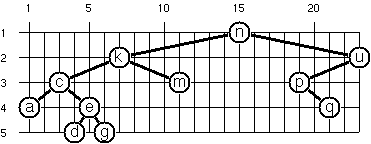 An alternative layout method is
depicted in the illustration opposite. Find out the rules and write the
corresponding method. Hint: On a given level, the horizontal distance
between neighboring nodes is constant.
An alternative layout method is
depicted in the illustration opposite. Find out the rules and write the
corresponding method. Hint: On a given level, the horizontal distance
between neighboring nodes is constant.
Use the same conventions as in problem P64.
scala> Node('a', Node('b', End, Node('c')), Node('d')).layoutBinaryTree2
res0: PositionedNode[Char] = T[3,1]('a T[1,2]('b . T[2,3]('c . .)) T[5,2]('d . .))
The tree at right may be constructed
with Tree.fromList(List('n','k','m','c','a','e','d','g','u','p','q')).
Use it to check your code.
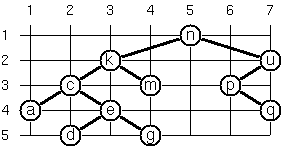 Yet another layout strategy is shown
in the illustration opposite. The method yields a very compact layout
while maintaining a certain symmetry in every node. Find out the rules
and write the corresponding method. Hint: Consider the horizontal
distance between a node and its successor nodes. How tight can you pack
together two subtrees to construct the combined binary tree?
Yet another layout strategy is shown
in the illustration opposite. The method yields a very compact layout
while maintaining a certain symmetry in every node. Find out the rules
and write the corresponding method. Hint: Consider the horizontal
distance between a node and its successor nodes. How tight can you pack
together two subtrees to construct the combined binary tree?
Use the same conventions as in problem P64 and P65. Note: This is a difficult problem. Don't give up too early!
scala> Node('a', Node('b', End, Node('c')), Node('d')).layoutBinaryTree3
res0: PositionedNode[Char] = T[2,1]('a T[1,2]('b . T[2,3]('c . .)) T[3,2]('d . .))
Which layout do you like most?
 Somebody represents binary trees as
strings of the following type (see example opposite):
Somebody represents binary trees as
strings of the following type (see example opposite):
a(b(d,e),c(,f(g,)))
Write a method which generates this string representation, if the
tree is given as usual (in Nodes and Ends).
Use that method for the Tree class's and
subclass's toString methods. Then write a method (on
the Tree object) which does this inverse; i.e. given the
string representation, construct the tree in the usual form.
For simplicity, suppose the information in the nodes is a single letter and there are no spaces in the string.
scala> Node('a', Node('b', Node('d'), Node('e')), Node('c', End, Node('f', Node('g'), End))).toString
res0: String = a(b(d,e),c(,f(g,)))
scala> Tree.fromString("a(b(d,e),c(,f(g,)))")
res1: Node[Char] = a(b(d,e),c(,f(g,)))a) Write methods preorder and inorder that
construct the preorder and inorder sequence of a given binary tree,
respectively. The results should be lists,
e.g. List('a','b','d','e','c','f','g') for the preorder
sequence of the example in problem P67.
scala> Tree.string2Tree("a(b(d,e),c(,f(g,)))").preorder
res0: List[Char] = List(a, b, d, e, c, f, g)
scala> Tree.string2Tree("a(b(d,e),c(,f(g,)))").inorder
res1: List[Char] = List(d, b, e, a, c, g, f)
b) If both the preorder sequence and the inorder sequence of the
nodes of a binary tree are given, then the tree is determined
unambiguously. Write a method preInTree that does the
job.
scala> Tree.preInTree(List('a', 'b', 'd', 'e', 'c', 'f', 'g'), List('d', 'b', 'e', 'a', 'c', 'g', 'f'))
res2: Node[Char] = a(b(d,e),c(,f(g,)))
What happens if the same character appears in more than one node?
Try, for instance, Tree.preInTree(List('a', 'b', 'a'), List('b',
'a', 'a')).
End) is encountered during the tree
traversal. For example, the tree shown in
problem P67 is represented
as "abd..e..c.fg...". First, try to establish a syntax
(BNF or syntax diagrams) and then write two
methods, toDotstring and fromDotstring, which
do the conversion in both directions.
scala> Tree.string2Tree("a(b(d,e),c(,f(g,)))").toDotstring
res0: String = abd..e..c.fg...
scala> Tree.fromDotstring("abd..e..c.fg...")
res1: Node[Char] = a(b(d,e),c(,f(g,)))The file containing the full class definitions for this section is tree.scala.
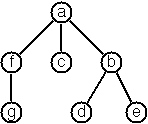 A multiway tree is composed of a root
element and a (possibly empty) set of successors which are multiway
trees themselves. A multiway tree is never empty. The set of successor
trees is sometimes called a forest.
A multiway tree is composed of a root
element and a (possibly empty) set of successors which are multiway
trees themselves. A multiway tree is never empty. The set of successor
trees is sometimes called a forest.
The code to represent these is somewhat simpler than the code for binary trees, partly because we don't separate classes for nodes and terminators, and partly because we don't need the restriction that the value type be ordered.
case class MTree[+T](value: T, children: List[MTree[T]]) {
def this(value: T) = this(value, List())
override def toString = "M(" + value.toString + " {" + children.map(_.toString).mkString(",") + "})"
}
object MTree {
def apply[T](value: T) = new MTree(value, List())
def apply[T](value: T, children: List[MTree[T]]) = new MTree(value, children)
}
The example tree is, thus:
MTree('a', List(MTree('f', List(MTree('g'))), MTree('c'), MTree('b', List(MTree('d'), MTree('e')))))
The starting code skeleton for this section is mtree1.scala.
nodeCount which counts the nodes of a
given multiway tree.
scala> MTree('a', List(MTree('f'))).nodeCount
res0: Int = 2 We suppose that the nodes of a
multiway tree contain single characters. In the depth-first order
sequence of its nodes, a special character ^ has been inserted whenever,
during the tree traversal, the move is a backtrack to the previous level.
We suppose that the nodes of a
multiway tree contain single characters. In the depth-first order
sequence of its nodes, a special character ^ has been inserted whenever,
during the tree traversal, the move is a backtrack to the previous level.
By this rule, the tree in the figure opposite is represented as:
afg^^c^bd^e^^^
Define the syntax of the string and write a
function string2MTree to construct an MTree
from a String. Make the function an
implicit conversion from String. Write the reverse
function, and make it the toString method of MTree.
scala> MTree('a', List(MTree('f', List(MTree('g'))), MTree('c'), MTree('b', List(MTree('d'), MTree('e'))))).toString
res0: String = afg^^c^bd^e^^^internalPathLength to return that sum.
scala> "afg^^c^bd^e^^^".internalPathLength res0: Int = 9
postorder which constructs the postorder
sequence of the nodes of a multiway tree. The result should be
a List.
scala> "afg^^c^bd^e^^^".postorder res0: List[Char] = List(g, f, c, d, e, b, a)
Our example tree would be represented in Lisp as (a (f g) c (b d
e)). The following pictures give some more examples.

Note that in the "lispy" notation a node with successors (children)
in the tree is always the first element in a list, followed by its
children. The "lispy" representation of a multiway tree is a sequence
of atoms and parentheses '(' and ')', with the atoms separated by
spaces. We can represent this syntax as a Scala String.
Write a method lispyTree which constructs a "lispy
string" from an MTree.
scala> MTree("a", List(MTree("b", List(MTree("c"))))).lispyTree
res0: String = (a (b c))
As a second, even more interesting, exercise try to write a method that takes a "lispy" string and turns it into a multiway tree.
[Note: Much of this problem is taken from the wording of the same problem in the Prolog set. This is certainly one way of looking at Lisp notation, but it's not how the language actually represents that syntax internally. I can elaborate more on this, if requested. <PMG>]
The complete source file for this section is mtree.scala.
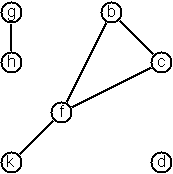 A graph is defined as a set of
nodes and a set of edges, where each edge is a pair of nodes.
A graph is defined as a set of
nodes and a set of edges, where each edge is a pair of nodes.
The class to represent a graph is mutable, which isn't in keeping with pure functional programming, but a pure functional data structure would make things much, much more complicated. [Pure functional graphs with cycles require laziness; I think Scala can handle it, but I think that would add too much of a barrier to the following questions. <PMG>]
Our Graphs use an incidence list internally. Each has a
list of nodes and a list of edges. Each node also has a list of edges
that connect it to other nodes. In a directed graph, nodes that are the
target of arcs do not have references to those arcs in their adjacency
list.
abstract class GraphBase[T, U] {
case class Edge(n1: Node, n2: Node, value: U) {
def toTuple = (n1.value, n2.value, value)
}
case class Node(value: T) {
var adj: List[Edge] = Nil
def neighbors: List[Node] = adj.map(edgeTarget(_, this).get)
}
var nodes: Map[T, Node] = Map()
var edges: List[Edge] = Nil
// If the edge E connects N to another node, returns the other node,
// otherwise returns None.
def edgeTarget(e: Edge, n: Node): Option[Node]
override def equals(o: Any) = o match {
case g: GraphBase[T,U] => (nodes.keys.toList -- g.nodes.keys.toList == Nil &&
edges.map(_.toTuple) -- g.edges.map(_.toTuple) == Nil)
case _ => false
}
def addNode(value: T) = {
val n = new Node(value)
nodes = Map(value -> n) ++ nodes
n
}
}
class Graph[T, U] extends GraphBase[T, U] {
override def equals(o: Any) = o match {
case g: Graph[T,U] => super.equals(g)
case _ => false
}
def edgeTarget(e: Edge, n: Node): Option[Node] =
if (e.n1 == n) Some(e.n2)
else if (e.n2 == n) Some(e.n1)
else None
def addEdge(n1: T, n2: T, value: U) = {
val e = new Edge(nodes(n1), nodes(n2), value)
edges = e :: edges
nodes(n1).adj = e :: nodes(n1).adj
nodes(n2).adj = e :: nodes(n2).adj
}
}
class Digraph[T, U] extends GraphBase[T, U] {
override def equals(o: Any) = o match {
case g: Digraph[T,U] => super.equals(g)
case _ => false
}
def edgeTarget(e: Edge, n: Node): Option[Node] =
if (e.n1 == n) Some(e.n2)
else None
def addArc(source: T, dest: T, value: U) = {
val e = new Edge(nodes(source), nodes(dest), value)
edges = e :: edges
nodes(source).adj = e :: nodes(source).adj
}
}
The full initial Graph code, which also includes objects for creating graphs, is in graph1.scala.
There are a few ways to create a graph from primitives. The graph-term form lists the nodes and edges separately:
Graph.term(List('b', 'c', 'd', 'f', 'g', 'h', 'k'),
List(('b', 'c'), ('b', 'f'), ('c', 'f'), ('f', 'k'), ('g', 'h')))
The adjacency-list form associates each node with its adjacent nodes. In an undirected graph, care must be taken to ensure that all links are symmetric--if b is adjacent to c, c must also be adjacent to b.
Graph.adjacent(List(('b', List('c', 'f')), ('c', List('b', 'f')), ('d', Nil),
('f', List('b', 'c', 'k')), ('g', List('h')), ('h', List('g')),
('k', List('f'))))
The representations we introduced so far are bound to our implementation and therefore well suited for automated processing, but their syntax is not very user-friendly. Typing the terms by hand is cumbersome and error-prone. We can define a more compact and "human-friendly" notation as follows: A graph is represented by a string of terms of the type X or Y-Z separated by commas. The standalone terms stand for isolated nodes, the Y-Z terms describe edges. If an X appears as an endpoint of an edge, it is automatically defined as a node. Our example could be written as:
[b-c, f-c, g-h, d, f-b, k-f, h-g]
We call this the human-friendly form. As the example shows, the list does not have to be sorted and may even contain the same edge multiple times. Notice the isolated node d.
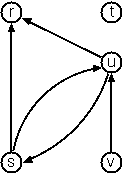 When the edges of a graph
are directed, we call them arcs. These are represented by
ordered pairs. Such a graph is called directed graph. To represent a
directed graph, the forms discussed above are slightly modified. The
example graph opposite is represented as follows:
When the edges of a graph
are directed, we call them arcs. These are represented by
ordered pairs. Such a graph is called directed graph. To represent a
directed graph, the forms discussed above are slightly modified. The
example graph opposite is represented as follows:
graph-term form:
Digraph.term(List('r', 's', 't', 'u', 'v'),
List(('s', 'r'), ('s', 'u'), ('u', 'r'), ('u', 's'), ('v', 'u')))
adjacency-list form:
Digraph.adjacent(List(('r', Nil), ('s', List('r', 'u')), ('t', Nil),
('u', List('r', 's')), ('v', List('u'))))
(Note that the adjacency-list form is the same for graphs and digraphs.)
human-friendly form:
[s>r, t, u>r, s>u, u>s, v>u]
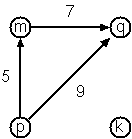 Finally, graphs and digraphs may
have additional information attached to nodes and edges (arcs). For the
nodes, this is no problem, as we can put any type into them. On the other
hand, for edges we have to extend our notation. Graphs with additional
information attached to edges are called labeled graphs.
Finally, graphs and digraphs may
have additional information attached to nodes and edges (arcs). For the
nodes, this is no problem, as we can put any type into them. On the other
hand, for edges we have to extend our notation. Graphs with additional
information attached to edges are called labeled graphs.
graph-term form:
Digraph.termLabel(List('k', 'm', 'p', 'q'),
List(('m', 'q', 7), ('p', 'm', 5), ('p', 'q', 9)))
adjacency-list form:
Digraph.adjacentLabel(
List(('k', Nil), ('m', List(('q', 7))), ('p', List(('m', 5), ('q', 9))),
('q', Nil)))
human-friendly form:
[p>q/9, m>q/7, k, p>m/5]
The notation for labeled graphs can also be used for so-called multi-graphs, where more than one edge (or arc) is allowed between two given nodes.
Graph. Write another method to output the
human-friendly form for a graph. Make it the toString
method for Graph. Write more functions to create graphs
from strings.
Hint: You might need separate functions for labeled and unlabeled graphs.
scala> Graph.fromString("[b-c, f-c, g-h, d, f-b, k-f, h-g]").toTermForm
res0: (List[String], List[(String, String, Unit)]) = (List(d, k, h, c, f, g, b),List((h,g,()), (k,f,()), (f,b,()), (g,h,()), (f,c,()), (b,c,())))
scala> Digraph.fromStringLabel("[p>q/9, m>q/7, k, p>m/5]").toAdjacentForm
res1: List[(String, List[(String, Int)])] = List((m,List((q,7))), (p,List((m,5), (q,9))), (k,List()), (q,List()))findPaths to find acyclic paths
from one node to another in a graph. The method should return all
paths.
scala> Digraph.fromStringLabel("[p>q/9, m>q/7, k, p>m/5]").findPaths("p", "q")
res0: List[List[String]] = List(List(p, q), List(p, m, q))
scala> Digraph.fromStringLabel("[p>q/9, m>q/7, k, p>m/5]").findPaths("p", "k")
res1: List[List[String]] = List()findCycles to find closed paths
(cycles) starting at a given node in a graph. The method should return
all cycles.
scala> Graph.fromString("[b-c, f-c, g-h, d, f-b, k-f, h-g]").findCycles("f")
res0: List[List[String]] = List(List(f, c, b, f), List(f, b, c, f))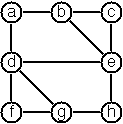 Write a
method
Write a
method spanningTrees to construct all spanning trees of a
given graph. With this method, find out how many spanning trees there
are for the graph depicted to the right. The data of this example graph
can be found below. When you have a correct solution for
the spanningTrees method, use it to define two other useful
methods: isTree and isConnected. Both are
five-minute tasks!
Graph:
Graph.term(List('a', 'b', 'c', 'd', 'e', 'f', 'g', 'h'),
List(('a', 'b'), ('a', 'd'), ('b', 'c'), ('b', 'e'),
('c', 'e'), ('d', 'e'), ('d', 'f'), ('d', 'g'),
('e', 'h'), ('f', 'g'), ('g', 'h')))
scala> Graph.fromString("[a-b, b-c, a-c]").spanningTrees
res0: List[Graph[String,Unit]] = List([a-b, b-c], [a-c, b-c], [a-b, a-c])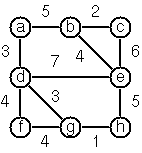 Write a
method
Write a
method minimalSpanningTree to construct the minimal
spanning tree of a given labeled graph. Hint: Use Prim's Algorithm. A
small modification of the solution of P83 does the
trick. The data of the example graph to the right can be found below.
Graph:
Graph.termLabel(
List('a', 'b', 'c', 'd', 'e', 'f', 'g', 'h'),
List(('a', 'b', 5), ('a', 'd', 3), ('b', 'c', 2), ('b', 'e', 4),
('c', 'e', 6), ('d', 'e', 7), ('d', 'f', 4), ('d', 'g', 3),
('e', 'h', 5), ('f', 'g', 4), ('g', 'h', 1)))
scala> Graph.fromStringLabel("[a-b/1, b-c/2, a-c/3]").minimalSpanningTree
res0: Graph[String,Int] = [a-b/1, b-c/2]Write a method that determines whether two graphs are isomorphic.
scala> Graph.fromString("[a-b]").isIsomorphicTo(Graph.fromString("[5-7]"))
res0: Boolean = trueNode.degree that determines the degree
of a given node.
scala> Graph.fromString("[a-b, b-c, a-c, a-d]").nodes("a").degree
res0: Int = 3
b) Write a method that lists all nodes of a graph sorted according to decreasing degree.
scala> Graph.fromString("[a-b, b-c, a-c, a-d]").nodesByDegree
res1: List[Graph[String,Unit]#Node] = List(Node(a), Node(c), Node(b), Node(d))
c) Use Welsh-Powell's algorithm to paint the nodes of a graph in such
a way that adjacent nodes have different colors. Make a
method colorNodes that returns a list of tuples, each of
which contains a node and an integer representing its color.
scala> Graph.fromString("[a-b, b-c, a-c, a-d]").colorNodes
res2: List[(Graph[String,Unit]#Node,Int)] = List((Node(a),1), (Node(b),2), (Node(c), 3), (Node(d), 2))scala> Graph.fromString("[a-b, b-c, e, a-c, a-d]").nodesByDepthFrom("d")
res0: List[String] = List(c, b, a, d)scala> Graph.fromString("[a-b, c]").splitGraph
res0: List[Graph[String,Unit]] = List([a-b], [c])scala> Digraph.fromString("[a>b, c>a, d>b]").isBipartite
res0: Boolean = true
scala> Graph.fromString("[a-b, b-c, c-a]").isBipartite
res1: Boolean = false
scala> Graph.fromString("[a-b, b-c, d]").isBipartite
res2: Boolean = true
scala> Graph.fromString("[a-b, b-c, d, e-f, f-g, g-e, h]").isBipartite
res3: Boolean = falseThe complete source file for this section is graph.scala.
Hint: Represent the positions of the queens as a list of numbers
1..N. Example: List(4, 2, 7, 3, 6, 8, 5, 1) means
that the queen in the first column is in row 4, the queen in the
second column is in row 2, etc. Use the generate-and-test paradigm.
Hints: Represent the squares by pairs of their coordinates of the form (X, Y), where both X and Y are integers between 1 and N. (Alternately, define a Point class for the same purpose.) Write a function jumps(N, (X, Y)) to list the squares that a knight can jump to from (X, Y) on a N×N chessboard. And finally, represent the solution of our problem as a list of knight positions (the knight's tour).
It might be nice to find more than one tour, but a computer will take a long time trying to find them all at once. Can you make a lazy list that only calculates the tours as needed?
Can you find only "closed tours", where the knight can jump from its final position back to its starting position?
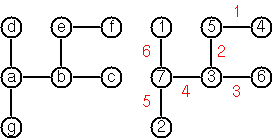
Anyway the puzzle goes like this: Given a tree with N nodes (and hence N-1 edges), find a way to enumerate the nodes from 1 to N and, accordingly, the edges from 1 to N-1 in such a way, that for each edge K the difference of its node numbers is equal to K. The conjecture is that this is always possible.
For small trees the problem is easy to solve by hand. However, for larger trees, and 14 is already very large, it is extremely difficult to find a solution. And remember, we don't know for sure whether there is always a solution!
Write a function that calculates a numbering scheme for a given tree. What is the solution for the larger tree pictured below?
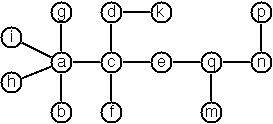
List(2,3,5,7,11) we can form the equations 2-3+5+7
= 11 or 2 = (3*5+7)/11 (and ten others!). In a certain programming language
(Ada) identifiers are defined by the syntax diagram (railroad chart)
opposite. Transform the syntax diagram into a system of syntax diagrams
which do not contain loops; i.e. which are purely recursive. Using
these modified diagrams, write a function isIdentifier that can check
whether or not a given string is a legal identifier.
In a certain programming language
(Ada) identifiers are defined by the syntax diagram (railroad chart)
opposite. Transform the syntax diagram into a system of syntax diagrams
which do not contain loops; i.e. which are purely recursive. Using
these modified diagrams, write a function isIdentifier that can check
whether or not a given string is a legal identifier. Problem statement Solution
. . 4 | 8 . . | . 1 7 9 3 4 | 8 2 5 | 6 1 7
| | | |
6 7 . | 9 . . | . . . 6 7 2 | 9 1 4 | 8 5 3
| | | |
5 . 8 | . 3 . | . . 4 5 1 8 | 6 3 7 | 9 2 4
--------+---------+-------- --------+---------+--------
3 . . | 7 4 . | 1 . . 3 2 5 | 7 4 8 | 1 6 9
| | | |
. 6 9 | . . . | 7 8 . 4 6 9 | 1 5 3 | 7 8 2
| | | |
. . 1 | . 6 9 | . . 5 7 8 1 | 2 6 9 | 4 3 5
--------+---------+-------- --------+---------+--------
1 . . | . 8 . | 3 . 6 1 9 7 | 5 8 2 | 3 4 6
| | | |
. . . | . . 6 | . 9 1 8 5 3 | 4 7 6 | 2 9 1
| | | |
2 4 . | . . 1 | 5 . . 2 4 6 | 3 9 1 | 5 7 8
Every spot in the puzzle belongs to a (horizontal) row and a (vertical) column, as well as to one single 3×3 square (which we call "square" for short). At the beginning, some of the spots carry a single-digit number between 1 and 9. The problem is to fill the missing spots with digits in such a way that every number between 1 and 9 appears exactly once in each row, in each column, and in each square.
The puzzle goes like this: Essentially, each row and column of a rectangular bitmap is annotated with the respective lengths of its distinct strings of occupied cells. The person who solves the puzzle must complete the bitmap given only these lengths.
Problem statement: Solution:
|_|_|_|_|_|_|_|_| 3 |_|X|X|X|_|_|_|_| 3
|_|_|_|_|_|_|_|_| 2 1 |X|X|_|X|_|_|_|_| 2 1
|_|_|_|_|_|_|_|_| 3 2 |_|X|X|X|_|_|X|X| 3 2
|_|_|_|_|_|_|_|_| 2 2 |_|_|X|X|_|_|X|X| 2 2
|_|_|_|_|_|_|_|_| 6 |_|_|X|X|X|X|X|X| 6
|_|_|_|_|_|_|_|_| 1 5 |X|_|X|X|X|X|X|_| 1 5
|_|_|_|_|_|_|_|_| 6 |X|X|X|X|X|X|_|_| 6
|_|_|_|_|_|_|_|_| 1 |_|_|_|_|X|_|_|_| 1
|_|_|_|_|_|_|_|_| 2 |_|_|_|X|X|_|_|_| 2
1 3 1 7 5 3 4 3 1 3 1 7 5 3 4 3
2 1 5 1 2 1 5 1
For the example above, the problem can be stated as the two lists
[[3],[2,1],[3,2],[2,2],[6],[1,5],[6],[1],[2]] and
[[1,2],[3,1],[1,5],[7,1],[5],[3],[4],[3]] which give the
"solid" lengths of the rows and columns, top-to-bottom and
left-to-right, respectively. Published puzzles are larger than this
example, e.g. 25×20, and apparently always have unique solutions.
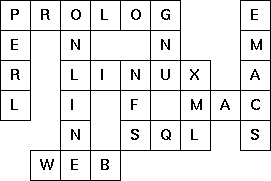 The particular crossword puzzle is
specified in a text file which first lists the words (one word per
line) in an arbitrary order. Then, after an empty line, the crossword
framework is defined. In this framework specification, an empty
character location is represented by a dot (.). In order to make the
solution easier, character locations can also contain predefined
character values. The puzzle opposite is defined in the
file p99a.dat, other examples
are p99b.dat
and p99d.dat. There is also an example of a
puzzle (p99c.dat) which does not have a
solution.
The particular crossword puzzle is
specified in a text file which first lists the words (one word per
line) in an arbitrary order. Then, after an empty line, the crossword
framework is defined. In this framework specification, an empty
character location is represented by a dot (.). In order to make the
solution easier, character locations can also contain predefined
character values. The puzzle opposite is defined in the
file p99a.dat, other examples
are p99b.dat
and p99d.dat. There is also an example of a
puzzle (p99c.dat) which does not have a
solution.
Words are strings of at least two characters. A horizontal or vertical sequence of character places in the crossword puzzle framework is called a site. Our problem is to find a compatible way of placing words onto sites.
Hints: (1) The problem is not easy. You will need some time to thoroughly understand it. So, don't give up too early! And remember that the objective is a clean solution, not just a quick-and-dirty hack!
(2) For efficiency reasons it is important, at least for larger puzzles, to sort the words and the sites in a particular order. For this part of the problem, the solution of P28 may be very helpful.